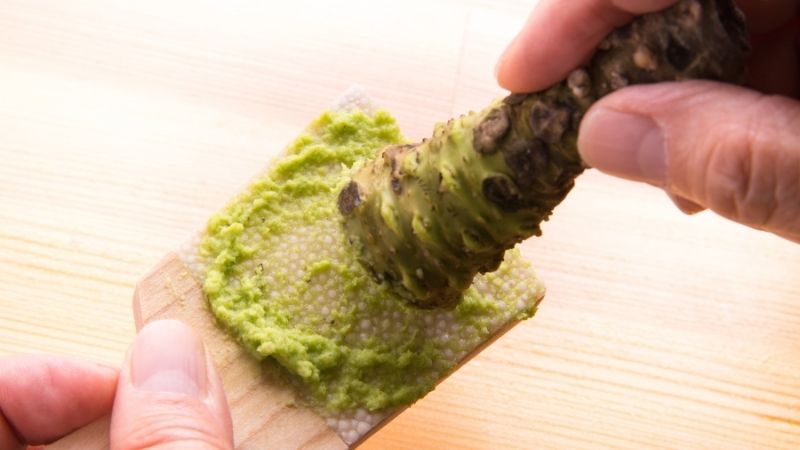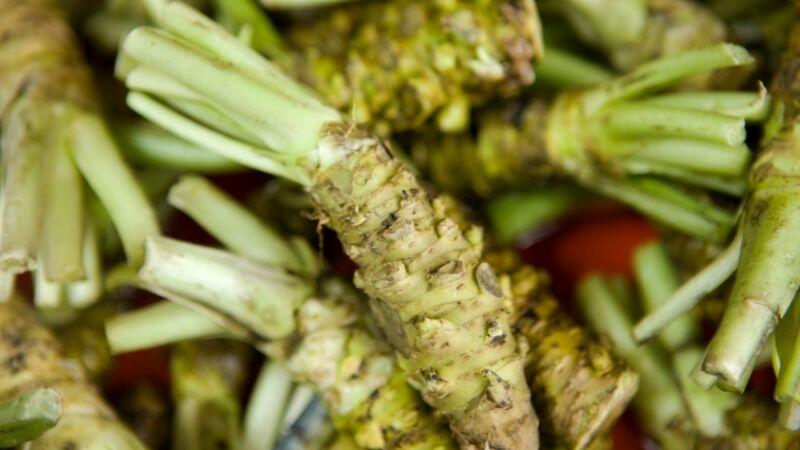Wasabi could feel pretty strange to you, especially if you are not Japanese. You might have tasted it in peas and sushi without knowing.
However, if you can stand the feeling of chilies, hot sauce, or other hot peppers, Is there a chance you could learn to appreciate Wasabi in no time?
Most people consider Wasabi extraordinarily spicy and hot compared to chili peppers and other spices. However, real Wasabi is not as spicy until you grate or pulverize it into a paste. It generates a burning sensation that fills your nose, enough to make your eyes tear and your brain tingle due to a reflex reaction from your brain that perceives its hot Phyto-compounds as toxic.
Since Wasabi is not part of the pepper family, people wonder why its flavor is so intense. Therefore, this article will cover everything you need to know about Wasabi’s spiciness and whether you are even eating the real Wasabi.
Keep reading for more information!
Is Wasabi Served in All Restaurants Equally Spicy?

Two types of Wasabi (real and fake) exist in restaurants. Although they both possess similar flavor and taste, they are not equally spicy.
- Real Wasabi: The original wasabi plant, native to Japan
- Fake Wasabi: The wasabi alternative in the united states and other places
The Spiciness of Real Wasabi?—What You Should Know.
The real Wasabi has its spiciness and flavor locked within its rhizome stem and is not as spicy until you grate the stems into a paste to release the flavor and spiciness.
Grating allows the phytochemicals responsible for Wasabi’s spiciness to react with air since they are primarily airborne.
Sometimes, you can feel its spiciness cleave up to your nose while grating it because of its airborne nature.

Real Wasabi is a rhizome plant from the same family of cruciferous vegetables like Cabbage, Brussel sprouts, Mustard, etc., and is native to Japan.
It is produced as a paste by grating or pulverizing the Wasabi stem into a paste that the Japanese natives use as an accompanying condiment for several raw foods, vegetables, and sushi.
The Spiciness of Fake Wasabi? —What You Should Know.
Fake Wasabi feels spicier until you taste the real Wasabi. The fake Wasabi blends regular horseradish with mustard and green coloring.
Horseradish is also from the cruciferous vegetable family and, like mustard, contains the same phytochemicals as the real Wasabi in smaller amounts.
Although the blend is pretty spicy, it is not as spicy as the authentic Wasabi paste.
You can perceive the difference in how your senses respond to the phytochemicals in the real Wasabi.
Since real Wasabi is very pricy, difficult to cultivate, and very rare in other places besides Japan, fake Wasabi is an ideal alternative, especially to replace the accompanying condiment for eating things like sushi.
There are greater chances that most people outside of Japan may never have tasted real Wasabi. However, the fake Wasabi is just as good and provides similar utility even with a less spicy concentration.
What Is the Science Behind Wasabi’s Intense Spicy Flavor?
The intense spicy flavor of Wasabi (real or fake) is due to the presence of an airborne photochemical called Allyl isothiocyanate.
When you consume Wasabi, the pain receptors lining your mucosal membranes send a message to your brain that interprets the phytochemicals as toxic.
It causes you to feel a burning sensation in your nose, mouth, tears in your eyes, and a tingling sensation in your brain.
Prolonged exposure to the substance can lead to headaches. Additionally, the receptor for Wasabi is TRPA 1 and detects both Wasabi and horseradish.
As a result, you feel almost the same degree of spiciness from both types of Wasabi (real and fake) because they share the same receptors.
Is Wasabi’s Spiciness the Same for Everyone?
Since the ability to perceive spicy or peppery flavor depends on your receptors, Wasabi’s spiciness is different for everyone. The reason is that some people have more receptors than others, depending on the individual’s genetic makeup.
As a result, the more your TRPA 1 receptor, the more intense the Wasabi’s flavor will be for you.
Also, the localized wasabi burn is different for everyone. While some people have more of the receptors in their nasal membrane, others might have more of it in their mouth. Therefore people’s response to Wasabi’s spiciness is both relative and arbitrary.
Health Benefits Associated With Wasabi’s Spiciness?
Wasabi remains a staple food condiment among the Japanese and worldwide for years because of its health benefits.
Even though it makes your nose burn, here are some health benefits associated with the spiciness of Wasabi:
- It maintains gut health and stability
- It may aid in reducing the risk of some cancer-associated health complications
- Possesses some antibacterial and anti-inflammatory qualities
- It prevents nausea and controls vomiting
- Adds more energy to foods as an accompanying condiment
- Enhances food flavor
Is Wasabi As Hot as Chili?
Although both Wasabi and Chills are hot, they are impossible to compare accurately. The reason is that the phytochemical responsible for Chili’s spiciness and the receptor for perceiving it is different for Wasabi. While Wasabi has the TRPA1 receptor, Chili has the TRPV1 receptor.
Additionally, Wasabi’s spiciness is due to the phytochemical, Allyl isothiocyanate. At the same time, Chili owes its spiciness to capsaicin, a phytochemical common in most peppers and targets the body’s temperature-regulating system.
As a result, you feel hot after eating Chili. On the other hand, you don’t feel hot after eating Wasabi. Instead, your body activates its toxin response reflex system causing your nose to burn.
Chili’s hotness lingers more than Wasabi’s because Wasabi’s spiciness is airborne and dissipates quickly through your nose. You most likely will sneeze more frequently when eating Wasabi. However, unlike Chili, Wasabi’s spiciness or hotness doesn’t last long.
Here is a comparison table to better explain how Wasabi’s spiciness is different from chili’s:
| Wasabi | Chili |
| Phytochemical is Allyl isothiocyanate. TargetsTRPA1 receptor responsible for responding to toxin invasion. Airborne spiciness Hotness does not linger and quickly dissipates The nose first perceives spiciness Not suitable for Scoville spiciness measurement. | Phytochemical is capsaicin. Targets TRPV1 receptor responsible for regulating body temperature. Oil binding spiciness Spiciness lingers and does not quickly dissipate. The mouth first perceives spiciness Suitable for Scoville spiciness measurement. |
Frequently Asked Questions
Why Does Wasabi Make Your Brain Tingle?
Your brain tingles as a reflex reaction to intense flavors on your palate. When substances containing strong flavors like Wasabi, peppers, onion, etc., contact your receptor cells, they directly signal distress to your brain.
Your brain responds by causing you to feel several sensations like burning, itchiness, coughing, choking, and teardrops.
What Happens When You Eat a Spoonful of Wasabi?
If you eat a spoonful of Wasabi, you could predispose yourself to broken heart syndrome, a similar illness to a heart attack. The broken heart syndrome presents as a heart attack with no blockage of the arteries.
Essentially, Wasabi should be a condiment accompanying the main dish and should not be consumed directly by a spoonful.
Why Is Wasabi So Intense?
Wasabi contains a Phytoelement called “allyl isothiocyanate.” It is an organic compound also found in mustard and several plants of the Cruciferae family.
As a result, the human reaction to the Phytoelement in Wasabi is responsible for its intense spicy and peppery flavor to the point that consuming Wasabi can cause your eyes to tear.
Final Thoughts
People generally use Wasabi as a spicy condiment to eat mainly raw foods like vegetables and reduce the smell of raw fish because of its intensely hot and spicy flavor. However, the degree of spicy perception is different for everyone.
Furthermore, consuming Wasabi with protein drinks like milkshakes will significantly reduce the burning effect on your nasal and palate receptors.





